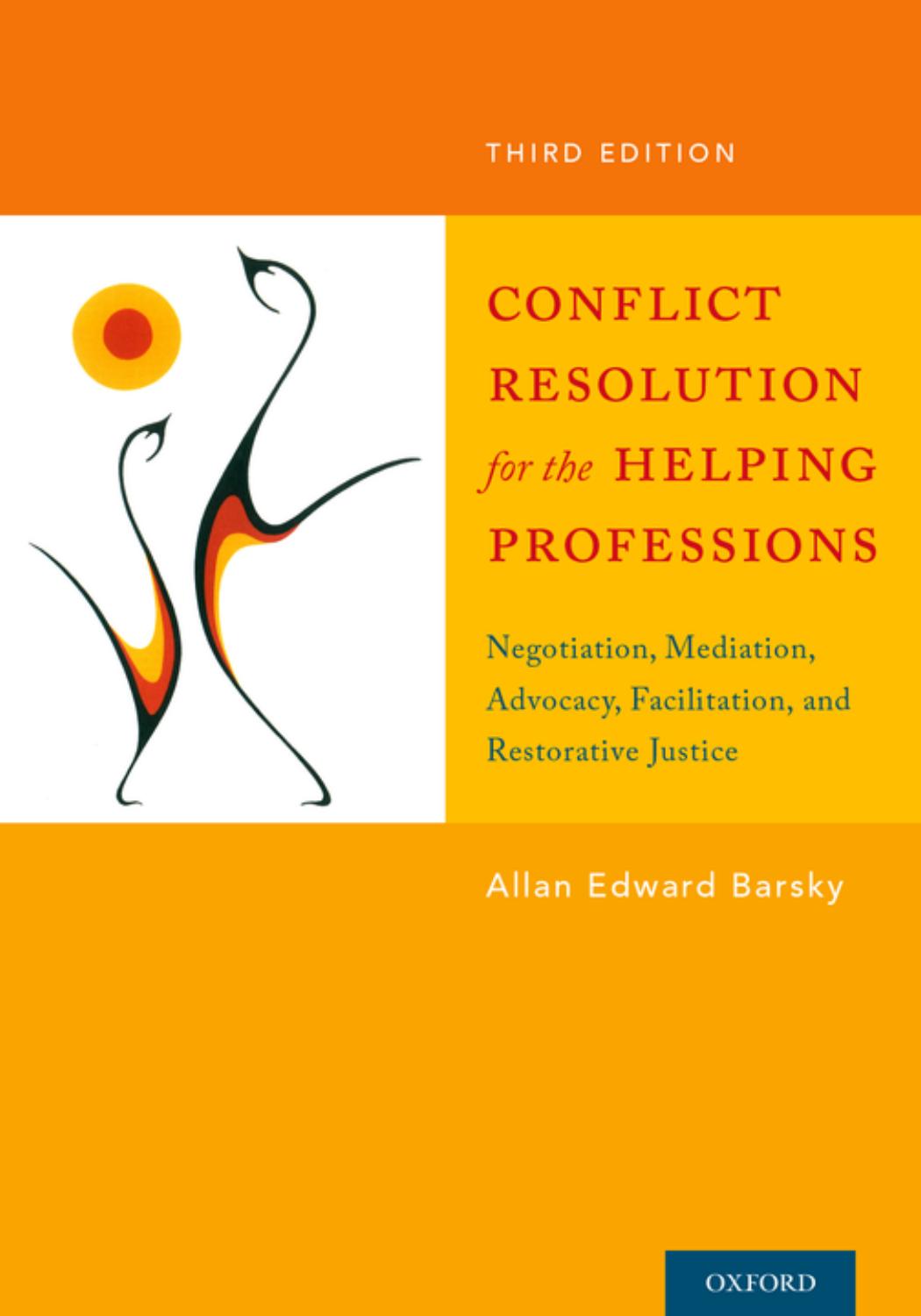

Most ebook files are in PDF format, so you can easily read them using various software such as Foxit Reader or directly on the Google Chrome browser.
Some ebook files are released by publishers in other formats such as .awz, .mobi, .epub, .fb2, etc. You may need to install specific software to read these formats on mobile/PC, such as Calibre.
Please read the tutorial at this link. https://ebooknice.com/page/post?id=faq
We offer FREE conversion to the popular formats you request; however, this may take some time. Therefore, right after payment, please email us, and we will try to provide the service as quickly as possible.
For some exceptional file formats or broken links (if any), please refrain from opening any disputes. Instead, email us first, and we will try to assist within a maximum of 6 hours.
EbookNice Team

Status:
Available4.5
32 reviews
ISBN 10: 0199361185
ISBN 13: 9780199361182
Author: Allan Edward Barsky, Professor Social Work Allan Barsky
When people think of conflict, they often think of fights, wars, arguments, hot tempers, and hurtful consequences. Conflict Resolution for the Helping Professions provides helping professionals with the theory, strategies, and skills they need to deal with conflict in a manner that is respectful, collaborative, and constructive. This text illustrates how helping professionals can incorporate evidence-based models of conflict resolution to work more effectively and enjoyably with clients, coworkers, supervisors, and others. Practitioners will learn how to respond effectively when others use power, positions, and competition. Whereas many conflict resolution texts focus on one method or approach to practice, this textbook provides practitioners with various models that they can incorporate in their roles as negotiators, counselors, mediators, facilitators, advocates, and peacebuilders. Special features of this book include:· Case illustrations that connect theory to practice in fields such as criminal justice, family disputes, health, mental health, education, and public policy.· Role-play exercises that provide opportunities to link self-awareness. · Step-by-step guides to implementing various approaches to negotiation, mediation, and advocacy.· New and emerging forms of conflict resolution, including online dispute resolution, conflict coaching, and parenting coordination. · Preparation tools that allow practitioners to assess conflict situations and determine the best strategies and approaches for managing conflict.· Strategies for enhancing mindfulness, enabling practitioners to respond to conflict in a deliberate, kind, nonjudgmental, peaceful, assertive, and effective manner.
Module I: Foundations of Conflict Resolution, Peace, and Restorative Justice
Conceptual Framework
Approaches to Conflict Resolution
Roles and Methods
Using This Text to Maximize Learning
Key Points
Discussion Questions and Exercises
Conflictia: The Context of the Role-Plays
Role-Play MI.1: “Suffer the Buffer”
1. The Mindful Practitioner
Being Mindful
Meditation
Reflection
1. Reflecting on Emotions
2. Reflecting on Cultural Influences
Spirituality: Inspiration and Artistry
Values and Ethics
1. In Search of Common Values
2. Satisfaction, Social Justice, and Transformation
3. Attitude toward Power
4. Professional Ethics
5. Values and Ethical Conflicts
Conflict Styles
1. Avoiding
2. Accommodating
3. Competing
4. Compromising
5. Collaborating
6. Selective Use of Styles
Basic Skills
1. Listening
2. Questioning
3. Making Statements
4. Written and Online Communication
Key Points
Safe Classroom and Constructive Feedback
Discussion Questions and Exercises
Role-Play 1.1: “Listening to Anger”
Role-Play 1.2: “Policies for Conflictia Hope”
2. The Theoretical Bases of Conflict Resolution
Biological Theories
Basic Human Needs Theory
Neuroscience
Psychological Theories
Personality Theories
Psychoanalytic Theories and Defense Mechanisms
Developmental Theories
Relative Deprivation Theory
Loss Theory
Behavioral Theories
Cognitive Theories
Resilience Theory
Humanism
Social Theories
Systems Theory
Communication Theory
Social Constructionism
Social Exchange Theory
Decision-Making Theories
Game Theory
Sociocultural Theories
The Collectivism–Individualism Continuum
Rigid–Flexible Concepts of Time
High–Low Power Distance Continuum
Language and Communication Styles
Value Differences
Social Identity Theory
Social Interdependence Theory
Conflict Theory
To What Ends?
Key Points
Discussion Questions and Exercises
Major Assignment
Assignment 2A: Observe and Analyze
3. Restorative Justice
Principles of Restorative Justice
1. Respect
2. Responsibility
3. Restoration (Making the Situation Right)
4. Healing
5. Relationships
6. Consensus
7. Truth
8. Safety
Roles of Helping Professionals
Contexts of Restorative Justice Practice
Restorative Justice in the Criminal Justice System
Restorative Justice in Schools
Restorative Justice in Child Protection
Large-Scale Violence and Oppression
Key Points
Discussion Questions and Exercises
Role-Play 3.1: “Coming Out—Coming Home”
Major Assignments
Assignment 3A: Planning a Restorative Justice Program
Assignment 3B: Evaluating a Restorative Justice Program
Module II: Negotiation
Contracting with Clients
Approaches to Negotiation
Cultural Diversity
Framework for Negotiation Processes
A. Preparation
B. Engagement and Planning
C. Discussion and Exploration
D. Bargaining
E. Obtaining Commitments
F. Implementation, Evaluation, and Follow-Up
Key Points
Discussion Questions and Exercises
Role-Play MII.1: “Contracting with Clem”
Role-Play MII.2: “Triage Tribulations”
4. Power-Based Negotiation
Rationale: Advantages and Disadvantages
Positional Bargaining
Opening Offers and Anchoring
Making Counteroffers and Concessions
Power-Based Strategies and Tactics
Tilting the Process in Your Favor
Knowing and Strengthening Your Alternatives
Gathering and Managing Information
Persuasion Strategies and Skills
Ethically Questionable Strategies and Skills
Stonewalling
Attacking
Deception
Acting in Bad Faith
Responding to Power-Based Strategies and Tactics
Raising Awareness
Focusing on Future Relations
Identifying Common Ground
Tit-for-Tat (Playing the Same Game)
Changing the Game
Protecting Self
Appeasing the Other Party
The Ethics of Power-Based Strategies
Honesty and Integrity
Informed Consent
Social Justice
Proportionality
Key Points
Discussion Questions and Exercises
Role-Play 4.1: “Malpractice Melee”
Role-Play 4.2: “Negotiating for Grades”
Role-Play 4.3: “Interprofessional Imbroglio”
5. Rights-Based Negotiation
What Is Rights-Based Negotiation?
Pros and Cons of Rights-Based Negotiation
Bargaining in the Shadow of other Rights-Based Processes
Negotiating Fact-Based Conflicts
Types of Evidence
Rights-Based Negotiation: Beyond the Facts
Negotiating Conflicts about Appropriateness or Fairness
Asserting the Law
Implicit Rights and Establishing Objective Criteria
Beyond Rights-Based Negotiation
Key Points
Discussion Questions and Exercises
Role-Play 5.1: “Sedation Squabble”
Role-Play 5.2: “Immigration Imbroglio”
Role-Play 5.3: “Joint Counseling Debate”
Role-Play 5.4: “What Do I Get for Role-Playing?”
6. Interest-Based Negotiation
Focus on Interests, Not Positions
Invent Options for Mutual Gain
Apply Objective Criteria
Improve Communication
Build a Positive Negotiating Relationship
Consider Alternatives
Obtain Commitments
Limitations of Interest-Based Negotiation
Key Points
Discussion Questions and Exercises
Tags: Allan Edward Barsky, Professor Social Work Allan Barsky, Conflict, Resolution